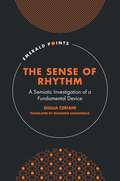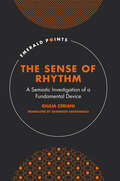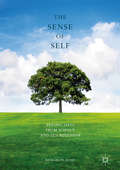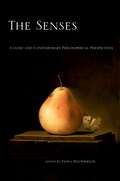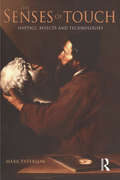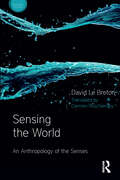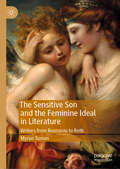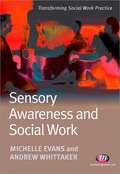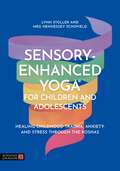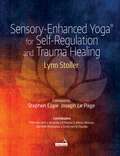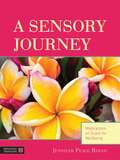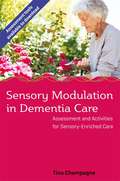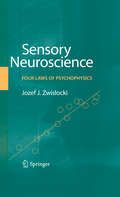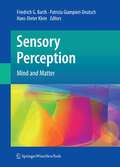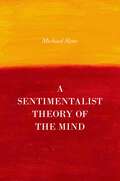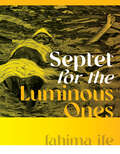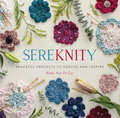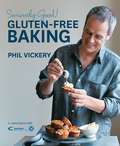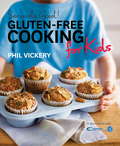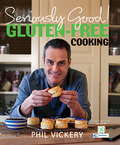- Table View
- List View
The Sense of Rhythm: A Semiotic Investigation of a Fundamental Device (Emerald Points)
by Giulia CerianiThe importance of rhythm spans time and space, its significance both natural and constructed. As contemporary society challenges us to search for connection, the question of rhythm is profoundly and uniquely capable of managing the exchange and dialogue between deep narrativity and surface figurativeness. A semiotic examination of the regulative efficacy of rhythm is at the centre of The Sense of Rhythm, which frames rhythm as a characteristic of texts and narratives in order to organize and sense meaning. Rhythm is capable of creating and conveying a passionate tone, and of fostering cross-disciplinary and cross-textual convergences. An awareness and recognition of rhythmic structure allows for potential to cross-code between perception and sensation across cultures. This new edition, published for the first time in English, brings semiotician Giulia Ceriani’s research to English-speaking students and researchers across disciplines. The Sense of Rhythm serves as a foundation for interdisciplinary research, creative practices, and a unique semiotic approach to the study of rhythm.
The Sense of Rhythm: A Semiotic Investigation of a Fundamental Device (Emerald Points)
by Giulia CerianiThe importance of rhythm spans time and space, its significance both natural and constructed. As contemporary society challenges us to search for connection, the question of rhythm is profoundly and uniquely capable of managing the exchange and dialogue between deep narrativity and surface figurativeness. A semiotic examination of the regulative efficacy of rhythm is at the centre of The Sense of Rhythm, which frames rhythm as a characteristic of texts and narratives in order to organize and sense meaning. Rhythm is capable of creating and conveying a passionate tone, and of fostering cross-disciplinary and cross-textual convergences. An awareness and recognition of rhythmic structure allows for potential to cross-code between perception and sensation across cultures. This new edition, published for the first time in English, brings semiotician Giulia Ceriani’s research to English-speaking students and researchers across disciplines. The Sense of Rhythm serves as a foundation for interdisciplinary research, creative practices, and a unique semiotic approach to the study of rhythm.
The Sense of Self: Perspectives from Science and Zen Buddhism
by Richard W. SearsAt the heart of this book is one of the most ancient and profound question philosophers, spiritual seekers, and curious individuals have pondered since the beginning of history: “Who am I?”. Advances in modern science, and access to Zen tradition, have provided us with broader and richer understanding of this topic. Over the chapters the author, a psychologist and Zen master, investigates how the brain fosters a sense of an independent self, situating his research in the contexts of neuroscience, ecology, evolution, psychology, and of the principles Eastern wisdom traditions. The book explores a broad range of insights from brain science, evolutionary biology, astronomy, clinical psychology, thoughts and emotions, mental health disorders, and Zen Buddhism. This book will appeal to psychologists, psychiatrists, social workers, counsellors, and researchers of Eastern traditions. General readers interested in the functioning of the brain will discover practical ways to integrate fascinating new findings on an age-old question into their everyday life.
The Senses: Classic and Contemporary Philosophical Perspectives (Philosophy of Mind)
by Fiona MacphersonThe senses, or sensory modalities, constitute the different ways we have of perceiving the world, such as seeing, hearing, touching, tasting and smelling. But how many senses are there? How many could there be? What makes the senses different? What interaction takes place between the senses? This book is a guide to thinking about these questions. Together with an extensive introduction to the topic, the book contains the key classic papers on this subject together with nine newly commissioned essays. One reason that these questions are important is that we are receiving a huge influx of new information from the sciences that challenges some traditional philosophical views about the senses. This information needs to be incorporated into our view of the senses and perception. Can we do this whilst retaining our pre-existing concepts of the senses and of perception or do we need to revise our concepts? If they need to be revised, then in what way should that be done? Research in diverse areas, such as the nature of human perception, varieties of non-human animal perception, the interaction between different sensory modalities, perceptual disorders, and possible treatments for them, calls into question the platitude that there are five senses, as well as the pre-supposition that we know what we are counting when we count them as five (or more). This book will serve as an inspiring introduction to the topic and as a basis from which further new research will grow.
The Senses of Touch: Haptics, Affects and Technologies
by Mark PatersonTouch is the first sense to develop in the womb, yet often it is overlooked. The Senses of Touch examines the role of touching and feeling as part of the fabric of everyday, embodied experience. How can we think about touch? Problems of touch and tactility run as a continuous thread in philosophy, psychology, medical writing and representations in art, from Ancient Greece to the present day. Picking through some of these threads, the book 'feels' its way towards writing and thinking about touch as both sensory and affective experience. Taking a broadly phenomenological framework that traces tactility from Aristotle through the Enlightenment to the present day, the book examines the role of touch across a range of experiences including aesthetics, digital design, visual impairment and touch therapies. The Senses of Touch thereby demonstrates the varieties of sensory experience, and explores the diverse range of our 'senses' of touch.
The Senses of Touch: Haptics, Affects and Technologies
by Mark PatersonTouch is the first sense to develop in the womb, yet often it is overlooked. The Senses of Touch examines the role of touching and feeling as part of the fabric of everyday, embodied experience. How can we think about touch? Problems of touch and tactility run as a continuous thread in philosophy, psychology, medical writing and representations in art, from Ancient Greece to the present day. Picking through some of these threads, the book 'feels' its way towards writing and thinking about touch as both sensory and affective experience. Taking a broadly phenomenological framework that traces tactility from Aristotle through the Enlightenment to the present day, the book examines the role of touch across a range of experiences including aesthetics, digital design, visual impairment and touch therapies. The Senses of Touch thereby demonstrates the varieties of sensory experience, and explores the diverse range of our 'senses' of touch.
Sensing the World: An Anthropology of the Senses (Sensory Studies)
by David Le BretonSensing the World: An Anthropology of the Senses is a highly original and comprehensive overview of the anthropology and sociology of the body and the senses. Discussing each sense in turn – seeing, hearing, touch, smell, and taste – Le Breton has written a truly monumental work, vast in scope and deeply engaging in style. Among other pioneering moves, he gives equal attention to light and darkness, sound and silence, and his disputation of taste explores aspects of disgust and revulsion. Part phenomenological, part historical, this is above all a cultural account of perception, which returns the body and the senses to the center of social life. Le Breton is the leading authority on the anthropology of the body and the senses in French academia. With a repute comparable to the late Pierre Bourdieu, his 30+ books have been translated into numerous languages. This is the first of his works to be made available in English. This sensuously nuanced translation of La Saveur du monde is accompanied by a spicy preface from series editor David Howes, who introduces Le Breton's work to an English-speaking audience and highlights its implications for the disciplines of anthropology, sociology, and the cross-disciplinary field of sensory studies.
Sensing the World: An Anthropology of the Senses (Sensory Studies)
by David Le BretonSensing the World: An Anthropology of the Senses is a highly original and comprehensive overview of the anthropology and sociology of the body and the senses. Discussing each sense in turn – seeing, hearing, touch, smell, and taste – Le Breton has written a truly monumental work, vast in scope and deeply engaging in style. Among other pioneering moves, he gives equal attention to light and darkness, sound and silence, and his disputation of taste explores aspects of disgust and revulsion. Part phenomenological, part historical, this is above all a cultural account of perception, which returns the body and the senses to the center of social life. Le Breton is the leading authority on the anthropology of the body and the senses in French academia. With a repute comparable to the late Pierre Bourdieu, his 30+ books have been translated into numerous languages. This is the first of his works to be made available in English. This sensuously nuanced translation of La Saveur du monde is accompanied by a spicy preface from series editor David Howes, who introduces Le Breton's work to an English-speaking audience and highlights its implications for the disciplines of anthropology, sociology, and the cross-disciplinary field of sensory studies.
The Sensitive Son and the Feminine Ideal in Literature: Writers from Rousseau to Roth
by Myron TumanThis book considers major male writers from the last three centuries whose relation to a strong, often distant woman—one sometimes modeled on their own mother—forms the romantic core of their greatest narratives. Myron Tuman explores the theory that there is an underlying psychological type, the sensitive son, connecting these otherwise diverse writers. The volume starts and ends with Jean-Jacques Rousseau, whose Confessions provides an early portrait of one such son. There are chapters on other adoring sons, Stendhal, Sacher-Masoch, Scott Fitzgerald, and Turgenev, as well as on sons like Bernard Shaw and D.H. Lawrence with a different, less affectionate psychological disposition toward women. This book demonstrates how, despite many differences, the best works of all these sensitive sons reflect the deep, contorted nature of their desire, a longing that often seems less for an actual woman than for an elusive feminine ideal.
Sensory Awareness and Social Work (1st edition) (PDF)
by Andrew Whittaker Michelle EvansUnderstanding sensory needs is fundamental for social work and care management practice. Social workers are trained to reflect on their own practice, make useful application of theory and promote anti-discriminatory practice at all times. This book will assist students in identifying people who have a sensory need and enable them to have the knowledge, skills and values to address this. Designed specifically to encourage students to build confidence and develop skills essential to best practice, this book is specifically structured to address all aspects of sensory need.
Sensory-Enhanced Yoga® for Children and Adolescents: Healing Childhood Trauma, Anxiety, and Stress Through the Koshas
by Lynn Stoller Meg Hennessey SchofieldThis evidence-based and trauma-informed resource allows professionals working with children and teens to apply sensory yoga as a holistic and effective tool in addressing symptoms of trauma, toxic stress, anxiety, depression, and related mental health conditions.Based on the Sensory and Mindfulness-based Yoga for Learning Environments (SMYLE™) model, this training program can easily be adopted by a wide range of professionals and applied to various settings, including schools, yoga classes, community centres, and group homes.In reducing stress, emotional dysregulation, and symptoms of hypervigilance and trauma, children and teens are able to benefit from a maintained state of calm and focus, and a heightened sense of self-worth and empowerment allowing for the long-term development of consistent healthy habits and routines.
Sensory-Enhanced Yoga® for Children and Adolescents: Healing Childhood Trauma, Anxiety, and Stress Through the Koshas
by Lynn Stoller Meg Hennessey SchofieldThis evidence-based and trauma-informed resource allows professionals working with children and teens to apply sensory yoga as a holistic and effective tool in addressing symptoms of trauma, toxic stress, anxiety, depression, and related mental health conditions.Based on the Sensory and Mindfulness-based Yoga for Learning Environments (SMYLE™) model, this training program can easily be adopted by a wide range of professionals and applied to various settings, including schools, yoga classes, community centres, and group homes.In reducing stress, emotional dysregulation, and symptoms of hypervigilance and trauma, children and teens are able to benefit from a maintained state of calm and focus, and a heightened sense of self-worth and empowerment allowing for the long-term development of consistent healthy habits and routines.
Sensory-Enhanced Yoga® for Self-regulation and Trauma Healing
by Lynn StollerLynn Stoller, OT, MS, OTR, C-IAYT, RYT500, E-RYT200 and outstanding expert contributors skilfully synthesize theoretical concepts and research findings from the fields of occupational therapy, trauma psychology, neuroscience, and traditional Eastern yogic philosophy to produce a Transdisciplinary Model for Post-Traumatic Growth for healing symptoms of combat stress, PTSD, or other unresolved trauma or anxiety disorders. The model is informed by the highly successful yoga treatment protocol used with U.S. military personnel deployed to Kirkuk, Iraq, which the author co-developed (Stoller et al, 2012) and by her experiences teaching yoga to veterans in her local community. Sensory-Enhanced Yoga (R) is designed to help meet the following goals:Decrease hypervigilance and overreaction to sensory input (e.g.visual, crowds, touch, noise, movement).Improve quality of sleep and energy level to support wellness and enhance daily productivity.Decrease intrusive thoughts by learning to become present through breath and body awareness.Enhance one's sense of self-worth and personal empowerment.Whether you are a therapist looking for effective treatment tools for your clients or are seeking healing for yourself, this insightful book will provide you with effective strategies to help promote peace of mind and full engagement in life. Lynn's website: www.sensoryenhancedyoga.org
A Sensory Journey: Meditations on Scent for Wellbeing
by Jennifer Peace RhindScent is often used to accompany meditation but is rarely the focus of it. This card set, which brings together ancient and contemporary understanding of the influence of aromatics on our wellbeing, is an introduction to meditating on scent and discovering the physical, emotional and spiritual benefits of beginning your own sensory journey. 'A Sensory Journey' guides and informs scent meditations. By meditating on the fragrance itself, rather than using it as an adjunct to other meditation rituals (through burning incense or scented candles), fragrance can go beyond merely enhancing or modifying our moods and become a key means to personal and spiritual growth. These cards, and the accompanying booklet and sensory map, explore different fragrances and make the benefits of scent meditation accessible to all. Each of the 24 cards, which are arranged in botanical groupings, features a scent description, an image of the botanical source, and inspirational words about the scent's evocative influence to help guide meditation. This unique and accessible card set is perfect for anyone interested in meditation, personal growth and the use of fragrance to enhance wellbeing.
A Sensory Journey: Meditations on Scent for Wellbeing (PDF)
by Jennifer Peace RhindScent is often used to accompany meditation but is rarely the focus of it. This card set, which brings together ancient and contemporary understanding of the influence of aromatics on our wellbeing, is an introduction to meditating on scent and discovering the physical, emotional and spiritual benefits of beginning your own sensory journey. 'A Sensory Journey' guides and informs scent meditations. By meditating on the fragrance itself, rather than using it as an adjunct to other meditation rituals (through burning incense or scented candles), fragrance can go beyond merely enhancing or modifying our moods and become a key means to personal and spiritual growth. These cards, and the accompanying booklet and sensory map, explore different fragrances and make the benefits of scent meditation accessible to all. Each of the 24 cards, which are arranged in botanical groupings, features a scent description, an image of the botanical source, and inspirational words about the scent's evocative influence to help guide meditation. This unique and accessible card set is perfect for anyone interested in meditation, personal growth and the use of fragrance to enhance wellbeing.
Sensory Modulation in Dementia Care: Assessment and Activities for Sensory-Enriched Care
by Tina ChampagneUnderstand and assess the sensory needs of people with dementia, and learn how to implement sensory modulation-based approaches for enriched care. Drawing on the author's Sensory Modulation Program, this approach aids with self-organization and meaningful participation in life activities. Explaining sensory-processing issues specific to older populations, this book provides a downloadable assessment tool to help review individual sensory-processing patterns. It includes a range of sensory-based activities which can be carried out with people at all stages of dementia, both with individuals and in groups. The book also provides recommendations for modifying physical environments to make care settings sensory-enriched.
Sensory Neuroscience: Four Laws Of Psychophysics
by Jozef J. ZwislockiSensory Neuroscience: Four Laws of Psychophysics organizes part of psychophysics -- a science of quantitative relationships between human sensations and the stimuli that evoke them. Although psychophysics belongs to sensory neuroscience, and is coupled to neurophysiology, it has also branched out to various specialized disciplines, including the disciplines of vision and hearing, ophthalmology, optometry, otology, and audiology. Due to this diversification and fragmentation, psychophysics has had an ad-hoc, phenomenological orientation. Besides Weber’s law of differential sensitivity, and the still-controversial Stevens’ power law, it has lacked a systematic grid of scientific laws. Sensory Neuroscience: Four Laws of Psychophysics provides valid unifying principles and systematic applications for this otherwise fragmented precursor of experimental psychology, and defines four multisensory relationships of substantial generality between sensations and the underlying stimulus variables. This book will be particularly useful to auditory researchers, experimental psychologists, and behavioral neuroscientists.
Sensory Perception: Mind and Matter
by Friedrich G. Barth Patrizia Giampieri-Deutsch Hans-Dieter KleinSensory perception: mind and matter aims at a deeper understanding of the many facets of sensory perception and their relations to brain function and cognition. It is an attempt to promote the interdisciplinary discourse between the neurosciences and psychology, which speaks the language of cognitive experiences, and philosophy, which has been thinking about the meaning and origin of consciousness since its beginning. Leading experts contribute to such a discourse by informing the reader about exciting modern developments, both technical and conceptual, and by pointing to the big gaps still to be bridged. The various chapters provide access to scientific research on sensory perception and the mind from a broad perspective, covering a large spectrum of topics which range from the molecular mechanisms at work in sensory cells to the study of the unconscious and to neurophilosophy.
A Sentimentalist Theory of the Mind
by Michael SloteMichael Slote argues that emotion is involved in all human thought and action on conceptual grounds, rather than merely being causally connected with other aspects of the mind. This kind of general sentimentalism about the mind goes beyond that advocated by Hume, and the book's main arguments are only partially anticipated in German Romanticism and in the Chinese philosophical tendency to avoid rigid distinctions between thought and emotion. The new sentimentalist philosophy of mind Slote proposes can solve important problems about the nature of belief and action that other approaches -- including Pragmatism -- fail to address. In arguing for the centrality of emotion within philosophy of the mind, A Sentimentalist Theory of the Mind continues the critique of rationalist philosophical views that began with Slote's Moral Sentimentalism (OUP, 2010) and continued in his From Enlightenment to Receptivity (OUP, 2013). This new book also delves into what is distinctive about human minds, arguing that there is a greater variety to ordinary human motives than has been recognized and that emotions play a central role in this complex psychology.
Septet for the Luminous Ones (Wesleyan Poetry Series)
by fahima ifeContinuing her search for a neotropical mythos, in this brilliant second collection poet fahima ife articulates various scenes of subduction. Spoken in quiet recognition and grounded in desire, Septet for the Luminous Ones imagines a lush soundscape textured in oblique spiritual fusion of the Taíno and Yoruba. Or, what it sounded like coming together for the first time, and what it sounds like ever after—breathless, diaspora calling. Similar to the incidents in Maroon Choreography, what resounds in these poems is an ecstatic love song of the Caribbean Americas, of the main lands and islands, shaped and reshaped as breathwork, ritual, communion, and fantasy. In essence, the collection speaks to raise the vibrational frequencies of all species on Earth through a sensual pulse of Black English.From Alchemical Sirensit flickers in balsamic appealmoist in the palms of our handsa psalm a lamp a sap in our lapsan aspplausible love song after love poemswere last put on holdas in b l a ck a r tthe new black art is this — find the lost soul and love it
SereKNITy: Peaceful Projects to Soothe and Inspire
by Nikki Van De CarSereKNITy: Peaceful Projects to Soothe and Inspire weaves mindful crafting and peaceful reflection into this simple, yet beautiful, collection of knitting and crochet patterns.The projects here are not the complicated sweater patterns found in traditional knitting guides, but simple, beautiful objects anyone can create. Practical crafts, like fingerless gloves and mug cozies, are featured alongside more meditative patterns, like granny squares and crocheted flowers. Each is paired with an inspirational, intention-setting prompt and falls under an overarching theme-Color, Texture, or Structure-that encourages knitters and crocheters of all skill levels to be fully present in the moment.Author and crafter Nikki Van De Car gently guides readers to look inward as they work, releasing their anxiety as they create something beautiful. For experienced knitters and novices alike, this is meditative crafting of the very best kind.
SereKNITy: Peaceful Projects to Soothe and Inspire
by Nikki Van De CarSereKNITy: Peaceful Projects to Soothe and Inspire weaves mindful crafting and peaceful reflection into this simple, yet beautiful, collection of knitting and crochet patterns. The projects here are not the complicated sweater patterns found in traditional knitting guides, but simple, beautiful objects anyone can create. Practical crafts, like fingerless gloves and mug cozies, are featured alongside more meditative patterns, like granny squares and crocheted flowers. Each is paired with an inspirational, intention-setting prompt and falls under an overarching theme-Color, Texture, or Structure-that encourages knitters and crocheters of all skill levels to be fully present in the moment. Author and crafter Nikki Van De Car gently guides readers to look inward as they work, releasing their anxiety as they create something beautiful. For experienced knitters and novices alike, this is meditative crafting of the very best kind.
Seriously Good! Gluten Free Baking
by Phil VickeryThis is a collection of 70 mouthwatering gluten-free baking recipes that coeliacs have until now only been able to dream about. Baking is often the most difficult aspect of the gluten-free diet to overcome, as it is gluten that gives bread its elasticity and cakes their spring. Recipes for delicious gluten-free cakes, puddings and pastries are hard to find - all too often the results are disappointingly crumbly and dry. But Phil Vickery's easy-to-follow instructions and practical advice, which draw on his Michelin-honed cooking skills, will have you whipping up melt-in-the-mouth Blueberry Cheescake, Chestnut and Roasted Onion Bread, Springy Scones and Squidgy Chocolate Brownies in an instant.
Seriously Good! Gluten-Free Cooking
by Phil VickeryPhil Vickery believes that he can revolutionise the notoriously restrictive gluten-free diet. Using his Michelin-starred cooking talents and his nurturing of simple, honest ingredients, Phil has created over 150 recipes that coeliacs have until now only dreamed of. Food to enjoy, food that is nutritious, food that will make you feel good. There are recipes for breakfasts, healthy snacks, light lunches, easy suppers and sophisticated dinners, including Crispy Pork Salad with Lemon Dressing and a Lemon and Leek Risotto. Phil also brings his skills to cakes, puddings and pastries - recipes that are the hardest of all to find if you are following a gluten-free diet. The 30 sweet ideas include a Fudgy Almond Cake with Mint Syrup & Frosting, Millionaire's Shortbread with Bramley Apple Dip and a great kids' Birthday Cake Sponge. There are also a number of delicious bread ideas, including Chestnut & Roasted Onion Bread.
Seriously Good! Gluten-Free Cooking
by Phil VickeryPhil Vickery believes that he can revolutionise the notoriously restrictive gluten-free diet. Using his Michelin-starred cooking talents and his nurturing of simple, honest ingredients, Phil has created over 150 recipes that coeliacs have until now only dreamed of. Food to enjoy, food that is nutritious, food that will make you feel good. There are recipes for breakfasts, healthy snacks, light lunches, easy suppers and sophisticated dinners, including Crispy Pork Salad with Lemon Dressing and a Lemon and Leek Risotto. Phil also brings his skills to cakes, puddings and pastries - recipes that are the hardest of all to find if you are following a gluten-free diet. The 30 sweet ideas include a Fudgy Almond Cake with Mint Syrup & Frosting, Millionaire's Shortbread with Bramley Apple Dip and a great kids' Birthday Cake Sponge. There are also a number of delicious bread ideas, including Chestnut & Roasted Onion Bread.
